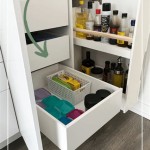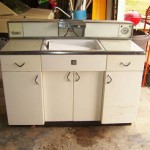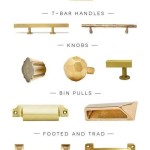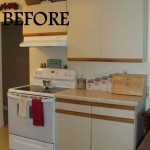The Allure and Application of Mix Colour Kitchen Cabinets
The kitchen, often considered the heart of the home, is a space where functionality meets aesthetics. Cabinetry plays a pivotal role in defining the kitchen’s overall design, influencing both its practicality and visual appeal. While monochromatic cabinet schemes offer simplicity and coherence, the use of mixed-colour kitchen cabinets has gained considerable traction in recent years. This approach allows for a more dynamic and personalized design, injecting character and visual interest into what can otherwise be a utilitarian space. Integrating different colours in kitchen cabinets requires careful planning and consideration of several factors to achieve a harmonious and balanced outcome.
Mix colour kitchen cabinets refer to the strategic combination of two or more distinct hues within the cabinetry system of a kitchen. This can manifest in various ways, from pairing upper and lower cabinets in contrasting shades to highlighting an island unit in a bold colour that deviates from the perimeter cabinets. Accent cabinets, such as those surrounding a refrigerator or range hood, can also be painted or finished in a different color to create a focal point and break up the monotony of a single-color scheme. The application of mixed colours allows for a greater degree of customization, creating kitchens that reflect the individual preferences and lifestyles of their owners.
The trend toward mix colour kitchen cabinets is driven by a desire to move beyond conventional, uniform designs. Homeowners seek to create spaces that are unique and expressive, and the strategic use of colour provides a powerful tool for achieving this. This approach is particularly well-suited for open-plan living spaces, where the kitchen often blends seamlessly with dining and living areas. Incorporating different colors in the cabinetry allows the kitchen to stand out as a distinct zone while still complementing the overall aesthetic of the connected spaces. Furthermore, mixed colour cabinets can be used to highlight architectural features, create visual depth, and subtly define different functional areas within the kitchen itself.
Achieving Balance and Harmony in Mixed-Colour Kitchens
The effective implementation of mixed-colour cabinetry hinges on establishing a sense of balance and harmony. This involves careful consideration of the color palette, the proportions of each color used, and the overall aesthetic goals of the design. A haphazard approach can result in a visually chaotic and unappealing kitchen. Therefore, a strategic and well-thought-out plan is essential to ensure a cohesive and aesthetically pleasing result.
One crucial consideration is the overall color scheme of the kitchen and the adjacent spaces. The chosen colors for the cabinets should complement the existing wall colors, flooring materials, countertops, and appliances. It is advisable to select a primary color that will dominate the overall scheme and then introduce a secondary color, or even a third accent color, to create contrast and visual interest. The 60-30-10 rule, commonly used in interior design, can be a useful guideline. This involves allocating 60% of the space to the primary color, 30% to a secondary color, and 10% to an accent color. Applied to kitchen cabinets, this might mean using the primary color for the majority of the base cabinets, the secondary color for the upper cabinets, and the accent color for the kitchen island or a single focal-point cabinet.
Another important aspect is the distribution of colors within the kitchen. Darker colors tend to visually ground the space, while lighter colors create a sense of openness and airiness. Using darker colors on the lower cabinets and lighter colors on the upper cabinets is a common approach that helps to create a balanced and visually appealing effect. This strategy also helps to make the kitchen feel more spacious, especially in smaller kitchens. Conversely, using lighter colors on the base cabinets and darker colors on the upper cabinets can create a more dramatic and intimate atmosphere, but this approach should be used with caution, as it can potentially make the kitchen feel smaller and enclosed.
The choice of complementary colors is also crucial for achieving a harmonious look. Complementary colors are those that sit opposite each other on the color wheel, such as blue and orange, or red and green. When used together, they create a strong visual contrast that can be very effective. However, it is important to use these colors in moderation, as too much contrast can be overwhelming. Analogous colors, which are those that sit next to each other on the color wheel, such as blue and green, or yellow and orange, offer a more subtle and harmonious effect. These colors blend seamlessly together, creating a sense of calm and tranquility.
Material Considerations in Mixed-Colour Cabinetry
The choice of materials for mixed-colour kitchen cabinets is inextricably linked to the overall aesthetic and functional performance of the kitchen. The materials selected must not only complement the chosen color palette but also withstand the rigors of daily use in a high-traffic environment. Durability, maintenance requirements, and cost are all important factors to consider when selecting materials for kitchen cabinetry.
Wood remains a popular choice for kitchen cabinets, offering warmth, character, and versatility. Different wood species, such as maple, oak, cherry, and walnut, possess unique grain patterns and natural color variations that can be enhanced or subdued through staining or painting. For mixed-colour schemes, it is common to use painted wood for the majority of the cabinets and incorporate a natural wood finish on select elements, such as a kitchen island or accent cabinets. This combination creates a visually appealing contrast between the painted surfaces and the natural wood grain.
Laminate is another widely used material for kitchen cabinets, offering a cost-effective and durable alternative to wood. Laminate cabinets are available in a vast array of colors, patterns, and textures, including realistic wood-grain finishes. They are also relatively easy to clean and maintain, making them a practical choice for busy kitchens. For mixed-colour schemes, laminate cabinets can be used to create bold and vibrant color combinations, as the material is available in a wide range of solid colors that are not easily achievable with wood.
Other materials, such as metal, glass, and acrylic, can also be incorporated into mixed-colour kitchen cabinet designs. Metal accents, such as stainless steel or brushed nickel hardware, can add a touch of modern sophistication. Glass-front cabinets can be used to display decorative items and create a sense of openness. Acrylic cabinets offer a sleek and contemporary look, and they are available in a range of translucent and opaque colors. Using different materials in combination with mixed colours can add visual depth and texture to the kitchen, creating a truly unique and personalized space.
The finish applied to the cabinets also plays a significant role in the overall aesthetic and durability. Matte finishes are popular for their understated elegance and ability to conceal imperfections. Glossy finishes offer a high-shine, contemporary look, but they are more prone to showing fingerprints and smudges. Semi-gloss finishes provide a balance between the two, offering a subtle sheen and good durability. The choice of finish should be carefully considered in relation to the chosen colours and materials, as well as the overall aesthetic goals of the design.
Design Considerations for Specific Kitchen Layouts
The layout of the kitchen significantly influences the effectiveness of mixed-colour cabinetry. Different kitchen layouts, such as galley kitchens, L-shaped kitchens, and U-shaped kitchens, present unique challenges and opportunities for incorporating different colors into the cabinetry system. The placement and proportion of the colors should be carefully considered in relation to the overall layout to achieve a balanced and harmonious design.
In a galley kitchen, which is characterized by two parallel runs of cabinets, the use of mixed colours can help to create visual interest and break up the linear monotony of the space. Using a lighter color on the upper cabinets and a darker color on the lower cabinets can help to make the kitchen feel more spacious and airy. Introducing a contrasting accent color on the cabinet hardware or backsplash can add a touch of personality and visual appeal. Due to the typically confined space of a galley kitchen, use of highly contrasting colours should be carefully assessed to ensure the narrow space does not become overwhelming.
In an L-shaped kitchen, which consists of two runs of cabinets that meet at a right angle, the corner area can be a focal point for incorporating a different color. Using a contrasting color on the corner cabinet or the island unit can help to define the space and create a visual anchor. Alternatively, using the same color on both runs of cabinets can create a sense of continuity and flow. The placement of appliances should also be considered when choosing colors for an L-shaped kitchen, as the appliances can add to the overall visual balance.
U-shaped kitchens, which consist of three runs of cabinets that form a U shape, offer ample opportunities for experimenting with mixed colours. The central run of cabinets, often containing the sink or range, can be highlighted in a different color to create a focal point. Alternatively, the upper and lower cabinets can be painted in contrasting colors to create a sense of depth and dimension. In larger U-shaped kitchens, the kitchen island can be used as a separate zone with a different color scheme to differentiate it from the perimeter cabinets.
For kitchens with islands, the island presents a natural opportunity to introduce a contrasting color. This can be a bold statement colour that complements the perimeter cabinets or a more subtle shade that blends seamlessly with the overall scheme. When choosing a color for the island, it is important to consider the size and shape of the island, as well as its function. If the island is primarily used for food preparation, a darker color may be more practical, as it will be less likely to show stains and spills. If the island is primarily used for entertaining, a lighter color may be more appropriate, as it will create a more welcoming and inviting atmosphere.

Mixing Kitchen Cabinet Colors A Blissful Nest

Kitchen Confidential 7 Ways To Mix And Match Cabinet Colors

Mixing Kitchen Cabinet Colors A Blissful Nest

Mixing It Up With Cabinet Colors

26 Two Tone Kitchen Cabinet Ideas That Make A Dazzling Duo

18 Examples Of Two Toned Kitchen Cabinets From Designers

Mixing Cabinet Colors In The Kitchen
:strip_icc()/twotonedlouisduncan-91b9d7ab761d47bcbf346a6c5e955e42.jpeg?strip=all)
30 Stylish Two Toned Kitchen Ideas From An Expert

Mixed Color Cabinets Traditional Kitchen Seattle By Dk Martin Construction Houzz Ie

10 Two Tone Kitchen Cabinet Ideas 2025 Mix And Match
Related Posts








